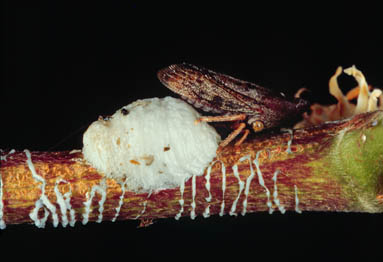Insect Diversity Project
Fort Sherman, Panama
Fort Sherman is at the wetter Caribbean end of the Canal Zone. It receives
an average of approvimately 3,500 mm of rainfall annually. Its
vegetation is classified as tropical wet forest. In 1997,
the Smithsonian Tropical Research Institute (STRI) constructed
a canopy crane to study the old-growth forest at Ft. Sherman.
In collaboration with investigators at STRI and the University of Panama, the
Insect Diversity Project plans to run canopy and ground Malaise traps
at this crane site in the near future.

An homopteran photographed on a canopy vine at Fort Sherman.
This species is being studied by Joseph Wright and
Hector Barrios
using the crane at Ft. Sherman.
They have also observed stingless bees tending these homopterans.
The white lines on the lower part of the branch
are a sticky defense that is capable of immobilizing ants.
Note what is presumed to be a small egg parasitoid on the branch below the
white egg mass.
Click on the image to get an enlargement. Be warned -- the
enlargement's jpg file is 632K.
[Photograph by John Pickering, July, 1997]

